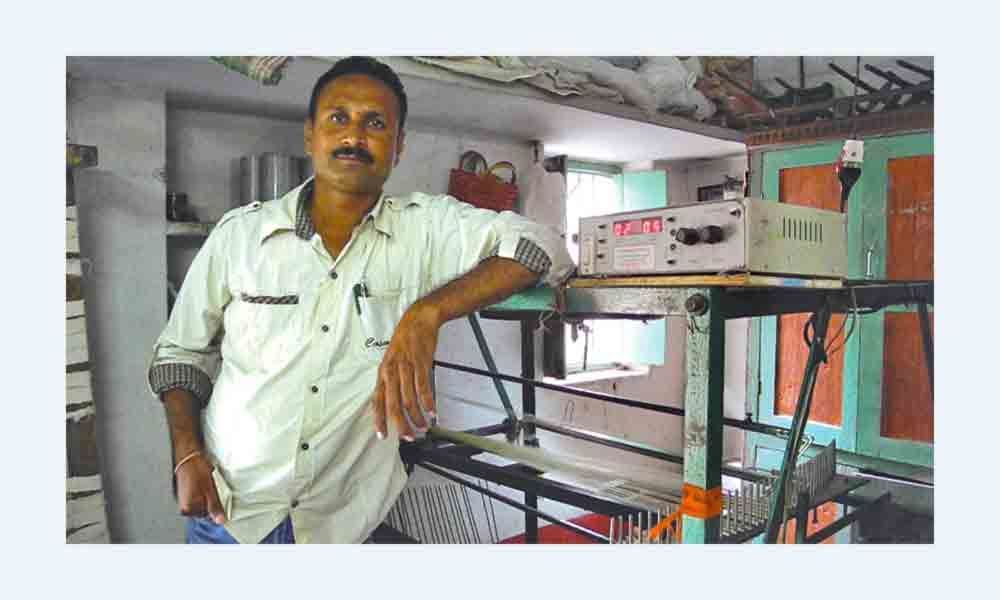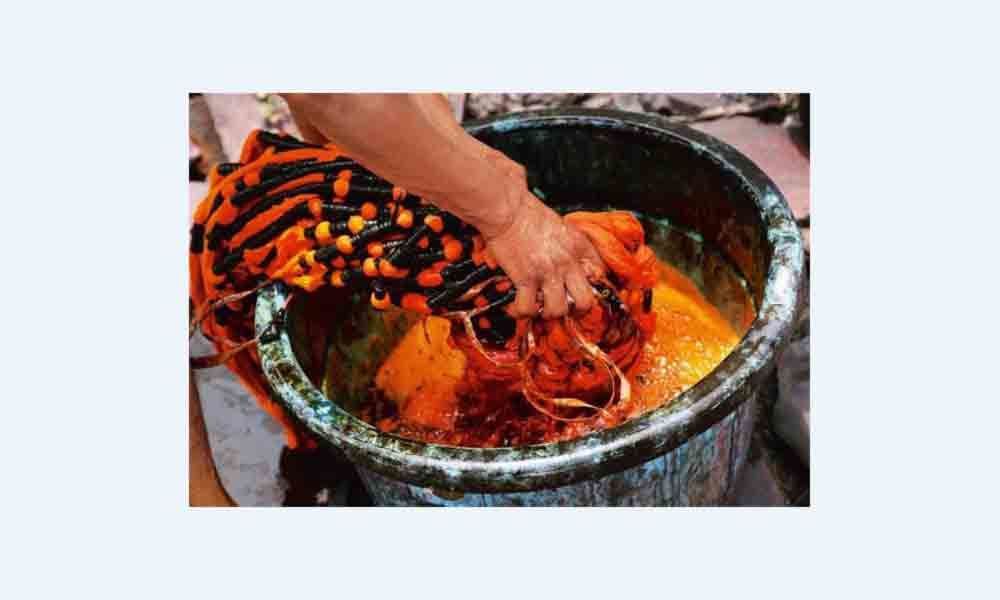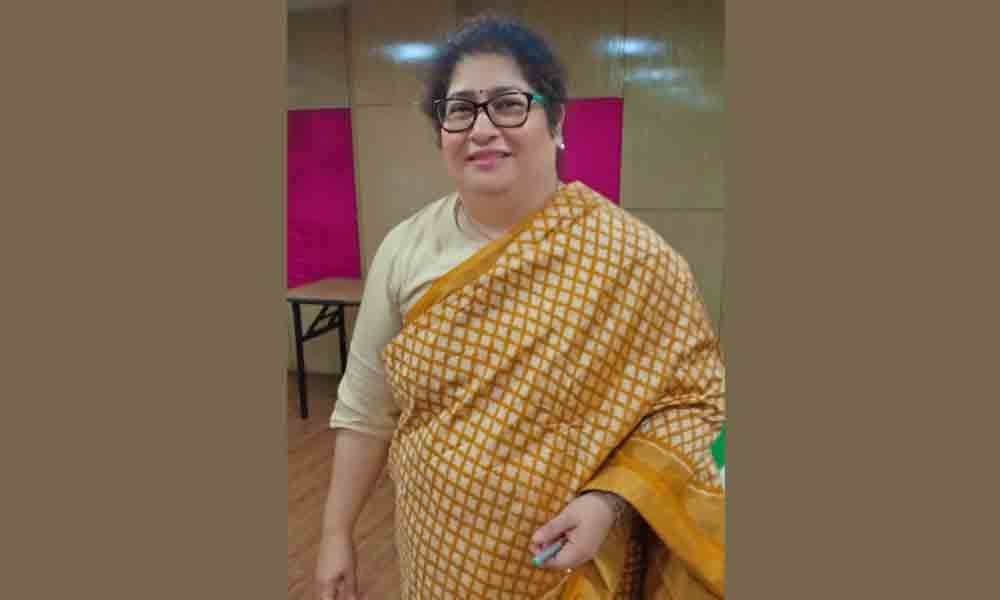Live
- Sundeep Kishan teams up with Thrinadha Rao Nakkina for ‘SK30’
- Kajal set to thrill audiences in action-packed role as ‘Satyabhama’
- Karnataka Chief Minister Siddaramaiah Offers Condolences To Grieving Father Of Stabbing Victim
- BJP winning 35 seats in Bengal will guarantee freedom from illegal infiltration: Amit Shah
- Assault Incident In Karnataka Sparks Controversy Amidst Rising Tensions
- Only 6 minutes’ role in 222 days at Parliament
- CM Kejriwal, K Kavitha’s judicial custody extended in money laundering case till May 7
- Women BJD leaders Raseswari, Simarani quit party
- BJP overlooked TG projects in Parliament: Manne Srinivas
- Nothing Phone 3 with Model Number A015 May Launch in July
Just In
Return of Telia Rumal: The bygone piece of marvel

Tel in Telia Rumal means oil, translating to yarn that was treated with oil and ash before weaving it into an intricate double Ikat pattern for a scarf, which was originally weaved in Chirala, Andhra Pradesh and used as headgear by Arabs and affluent Muslim men. The dye is distinctive red and only rumals were weaved until after the technique was adapted to weave saris, and the craft shifted its base to other places including Pochampalli. The increase in cheaper imitations and rise of mill produced fabrics was a death blow to export, and Telia Rumal weavers, who slowly began to decline with the younger generation in weavers' families refusing to take it up.
In the recent past, textile revivalists from the region began to focus on this beautiful fabric and started to experiment with it. The Department of Handlooms and Textiles (DHT) of Telangana is all set to revive the once-popular Telia Rumal and creation of Mahadevpur Tussar silk sarees in natural dyes on the occasion of National Handloom Day. On the sidelines of a presser Shailaja Ramaiyer, director, Handlooms & Textiles gave insights about Telia Rumal and plan to revive this beautiful technique.
The Telia Rumal is very complex and laborious double Ikat weave. The products used for the treatment of the yarn include sheep dung, castor pod ashes and oil. The treated yarn is used for the warp and weft and is tied and dyed according to prearranged geometrical design.
"Nobody knows about Telia Rumal anymore. The Telia Rumal is largely a men's product. It was originally exported to the Middle East and the Arab men used to wear it as a headgear; sometimes they also used it as a scarf, and on a few occasions, it was also used as a prayer mat, but that occurrence was very less. It is primarily worn as a head-dress from medieval ages. The point is that slowly in the Middle East also they have stopped using Telia Rumal as they started power loom production, I have seen articles on that. Gradually they also stopped importing from here and the whole process of Telia Rumal halted," Shailaja shared.
The process of making Telia Rumal is long and tedious. It involves a lot of handworks. "The weavers in the ikat area stopped making Telia Rumals and they moved from making head-dress and menswear to creating only women's wear because that was where the local market was. It was an export item largely. People are forgetting about this art form. When we also walked about in Puttapaka and Pochampalli areas, we were trying to see if anybody knew the process, however, we could not find more than 2-3 people. We intend to revive something special, and Telia Rumal is like a work of art.
"Making of Telia Rumal is a process of minimum 2-3 months. The artisans have to dip the yarn in various things right from goat's dung to castor pod ash; then they have to apply castor oil on the yarn, dry it; so, this process of dipping-dyeing itself takes 20-25 days. After the yarn preparation is done then the dyeing process starts, and it is double ikat weave. Now double ikkat means you double the work. You have to tie and dye the warp and tie and dye the weft. This whole process is such a big piece of art; it is not just an ordinary cloth. Hence, there is a dire need to revive it because we could proudly say that Telia Rumal does not exist anywhere else apart from Telangana."
Chintakindi Mallesham, who made Asu Machine and a Padma Shri awardee said, "Telia Rumal is an intricate work of art and like all handlooms it has taken a hit. I am glad that the efforts to revive such a beautiful artform. As it is a part of ikkat work our Asu machine will be helpful to reduce the workload on artisans."
Telia Rumal is not from Telangana. It is from Chirala, Andhra Pradesh. Chirala is a coastal town and it always had trade with Arabs since Medieval times and this Telia Rumal export was a special trade that was happening from there. The place has always been a weaving cluster in AP. Originally even ikat was woven and exported from Chirala. When weavers migrated from Chirala to Puttapaka, they carried their tradition along with them, but eventually, it died out almost completely, barring very few revivers working on it.
A Gajam Govardan, a master weaver in Ikkat and Padma Shri, UNESCO Awardee from Puttapaka village in Telangana shares the importance of Telia Rumal. "It is not a chemical dye that is used in colouring. I am doing this work since 1968 and there is no one else doing such kind of work in my village. As we know making Telia Rumal is a long process. And every person has to follow the same process while making Telia Rumail. The best part of Telia Rumal is it counters the weather. If it is a hot day then the Rumal will keep you cool and if it is chilly then the cloth will keep you warm. This process started in Chirala and then slowly weavers stopped this process and then I started working on this process again. For three years this process has come into recognition again. This process cannot be done through computerised techniques, which are preferred by most of the young people. This process should be given its identity so that weavers get back to do these works again. Awareness should be made among people so that they could choose the right material of Telia Rumal. A proper documentation of this whole process should be shown to people so that this artwork is recognised and the value of the hard work by the weavers is credited."
Ramaiyer said that as a head-dress made from Telia Rumal keeps the head cool, and this could become the USP. "A scarf dyed with castor oil keeps the head cool and it is good for hot weather. No Gucci product and no Hermes scarf has these special qualities; so, I think it is far more precious, and it is up to us to market it in that fashion and that's what we are trying to do."

© 2024 Hyderabad Media House Limited/The Hans India. All rights reserved. Powered by hocalwire.com












